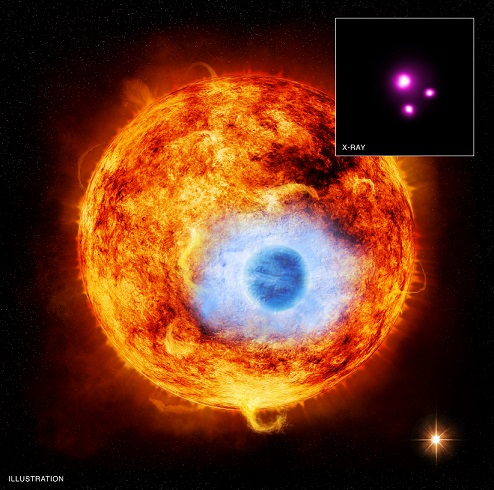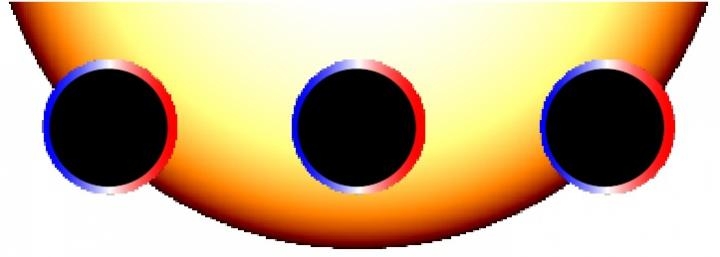Astronomers create the first weather map of a giant Jupiter-like exoplanet

For the first time, astronomers have actually mapped the weather of an exoplanet beyond our Solar System. Astronomers have found that gas giant HD 189733b has winds swirling at 8690 km/h (5400 mph). This is due to the planets extremely close orbit around its host star. This has also led to extreme temperatures on HD 189733b and a gradual evaporation of its gaseous atmosphere.
The team of astronomers from the University of Warwick, led by Tom Lauden, used the HARPS, the High Accuracy Radial velocity Planet Searcher, in La Silla, Chile to collect the data. Their findings have been published in the Astrophysical Journal Letters on November 11, 2015.

Blue planet HD 189733b around its host star (artist's impression). Video credit: ESA
HD 189733b is a Jupiter-like gas giant which moves in a tight orbit around its host star, located 63 light years away in the constellation Vulpecula. The planet moves extremely close to its host star, around 180 times closer than Mercury is from our sun. This has led to extremely high temperatures on the surface of HD 189733b, with day-time temperatures reaching an astounding 1 800 °C. Earlier research has also shown that the planet is cobalt-blue in color due to the presence of glass-like silicates and its closeness to its host star is slowly evaporating its largely gaseous atmosphere.
The relative nearness and the extremely tight orbit of this "Hot Jupiter" have always fascinated astronomers globally. The current research has shown that the wind speed on HD 189733b is 20 times the fastest wind and 7 times the speed of sound on Earth. Commenting on the research, lead researcher Tom Louden, of the University of Warwick's Astrophysics Group, said: "This is the first ever weather map from outside of our solar system. Whilst we have previously known of wind on exoplanets, we have never before been able to directly measure and map a weather system."


HD 189733b at three positions as it crosses its parent star. Image: University of Warwick
While studying the velocities on the two sides of exoplanet HD 189733b, researchers found extremely fast winds of 8 690 km/h (5 400 mph) blowing from its dayside (part facing towards the star) to its nightside (part facing away from the star). Mr Louden adds, "HD 189733b's velocity was measured using high resolution spectroscopy of the Sodium absorption featured in its atmosphere. As parts of HD 189733b's atmosphere move towards or away from the Earth the Doppler effect changes the wavelength of this feature, which allows the velocity to be measured."
He further explained that the surface of the star is brighter at the center than it is at the edge, so as the planet moves in front of the star the relative amount of light blocked by different parts of the atmosphere changes. "For the first time we've used this information to measure the velocities on opposite sides of the planet independently, which gives us our velocity map," Louden said.


X-ray flares stripping away gas giant HD 189733b's atmosphere. Video credit: NASA
Louden and his team feel that their research can potentially be used to study other Earth-like planets. Researcher Dr Peter Wheatley of the University of Warwick's Astrophysics Group said they are tremendously excited to have found a way to map weather systems on distant planets. "As we develop the technique further we will be able to study wind flows in increasing detail and make weather maps of smaller planets. Ultimately this technique will allow us to image the weather systems on Earth-like planets."
References:
- University of Warwick
- "Spatially Resolved Eastern Winds and Rotation of HD 189733b" by Tom Lauden et.al., accepted for publication by the Astrophyisical Journal Letters on November 11, 2015. arXiv:1511.03689
Featured image: Artist's impression of exoplanet HD 189733b orbiting its host star along with top-right x-ray image of the event detected by NASA's Chandra X-ray Observatory. Credit: NASA

Commenting rules and guidelines
We value the thoughts and opinions of our readers and welcome healthy discussions on our website. In order to maintain a respectful and positive community, we ask that all commenters follow these rules:
We reserve the right to remove any comments that violate these rules. By commenting on our website, you agree to abide by these guidelines. Thank you for helping to create a positive and welcoming environment for all.